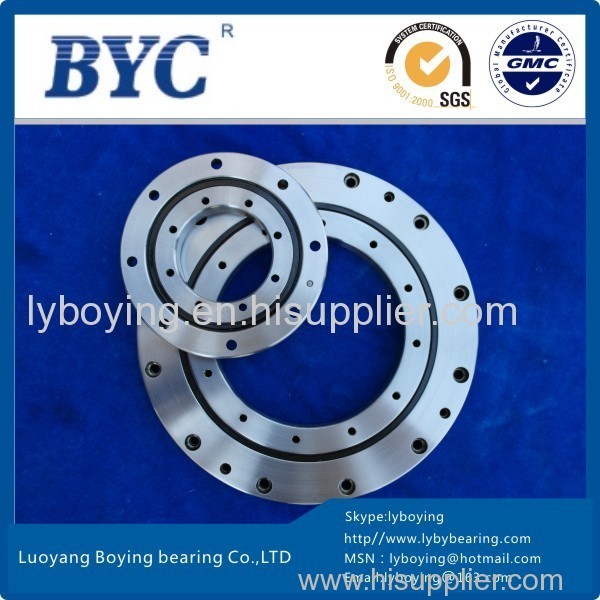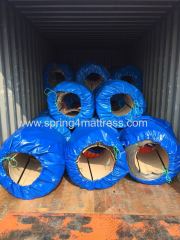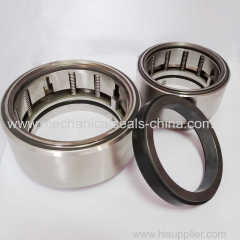Product (164)
- cylindrical thrust roller bearing (3)
- YRT rotary table bearing (28)
- cross tapered roller bearing (11)
- crossed roller bearing (122)
News (3)
Credit Report
Products Index
Company Info
Luoyang Boying Bearing Co.,Ltd [China (Mainland)]
Business Type:Manufacturer
City: Luoyang
Province/State: Henan
Country/Region: China (Mainland)
Premium Related Suppliers
News
BYC bearing news:The basic requirements for Smelting Quality Bearing Steel

The life and reliability of crossed roller bearings and rotary table bearing depends on the smelting of steel. Because of the special characteristics of bearing steel, the quality requirements of the smelting steelis stricter than the average industrialsuch as the steel chemical composition, purity, structure and uniformity and so on.
1. Thestrict requirements for chemical composition
BYC Crossed roller bearings and Rotary table bearing steel is mainly carbon chromium bearing steel (GCr15 bearing steel), carbon content isabout 1%, adding about 1.5% chromium, and contains a small amount of manganese, silicon over-eutectoid steel. Chrome Heat treatment can improve performance, increase hardenability, organizational uniformity, tempering stability, but also can improve the performance and rust-proof steel grinding performance. But when the chromium content more than 1.65%, the steel after quenching will increase the residual austenite and lower hardness and dimensional stability, increase the carbide inhomogeneity and reduce the impact toughness and fatigue strength of steel. so high-carbon chromium bearing steel contain chromium shall be under 1,65% or less. To meet the heat treatment process bearing properties and hardness by strictly controlling the chemical composition of bearing steel.
2. High-precision size requirements
Crossed roller bearings and Rotary table bearing steel require high dimensional accuracy, because most of the pressure bearing parts to go through the molding. In order to save material and improve labor productivity, most bearing rings are forged through the molding, steel ball after cold forging or hot forming, the small size roller has also taken a cold forging forming. If the steel is not high dimensional accuracy can not be used to calculate the size and weight of blanking, but can not guarantee quality of products bearing parts, are likely to cause damage to equipment and molds.
3, In particular the stringent purity requirements
Purity of steel is the steel contained in the non-metallic inclusions in the number, the higher the degree of purity, non-metallic inclusions in steel less. Bearing steel oxide, silicate, and other harmful inclusions leading to early bearing fatigue spalling, a significant reduction in the main bearing life. Brittle inclusions in particular the most harmful, since the process that can easily peel off from the metal substrate down, seriously affect the bearing parts after finishing the surface quality.Therefore, in order to improve bearing life and reliability, must be reduced bearing steel in the content of inclusions.
4, The strict low magnification and microscopic (high power) organizational requirements
BYC Bearing Steel low magnification refers to the general loose, center porosity and bian analysis, microscopy (high power) organizations, including the steel annealing organization, carbide mesh, ribbon, and liquid analysis and so on. Analysis of hard and brittle carbide solution, and its dangers and the same brittle inclusions. Carbide steel mesh to reduce the impact toughness, and make the organization uneven, and in easy to deformation and cracking during quenching. Strip annealing and quenching and tempering carbon impact organizations, and contact fatigue strength. Low, high-powered organization's strengths and weaknesses of the performance and service life of rolling bearings have a great impact, therefore, in the bearing material standards of the low, high-powered organizations have strict requirements.
5, In particular the stringent requirements surface defects and internal defects
Pairs of bearing steel, the surface defects, including cracks, slag, burrs, scarring, oxide and so on, the internal defects, including shrinkage, bubble, white spots, severe osteoporosis, and segregation and so on. Bearing these shortcomings for the processing, bearing performance and life of great influence, in the bearing materials, clearly defined standards for these shortcomings are not allowed.
6, In particular the stringent requirements of the carbide inhomogeneity
In the bearing steel, if there is a serious uneven distribution of carbide, then the heat treatment process can easily result in the organization and the hardness of the uneven, Steels heterogeneity on contact fatigue strength have a greater impact. In addition, serious non-uniformity of carbide is also easier to make when the bearing parts in quenching cooling cracks, carbide heterogeneity also lead to reduced life of bearings, therefore, in the bearing materials, standards for different specifications of steel have a clear special requirements.
7, In particular the stringent requirements of surface decarbonization layer
Standards in the bearing material layer on the steel surface decarbonization has strict rules, if the surface decarburization layer beyond the standard scope of the provisions, and in the heat treatment prior to processing has not removed all of its, then the process of heat treatment and quenching on the prone to quench cracking, resulting in scrapped parts.
8, Other requirements
In the bearing steel material standards also bearing steel smelting method, oxygen content, annealing hardness, fracture, residual elements, spark testing, delivery status, identity and other stringent requirements.
htt p://bycbeari ng.en.alibab a.com
htt p://ww w.byc bea rings.com/index.php?lang=2
htt p://w ww.ly bybearing.c om/index.php?lang=en
BYC Crossed roller bearings and Rotary table bearing steel is mainly carbon chromium bearing steel (GCr15 bearing steel), carbon content isabout 1%, adding about 1.5% chromium, and contains a small amount of manganese, silicon over-eutectoid steel. Chrome Heat treatment can improve performance, increase hardenability, organizational uniformity, tempering stability, but also can improve the performance and rust-proof steel grinding performance. But when the chromium content more than 1.65%, the steel after quenching will increase the residual austenite and lower hardness and dimensional stability, increase the carbide inhomogeneity and reduce the impact toughness and fatigue strength of steel. so high-carbon chromium bearing steel contain chromium shall be under 1,65% or less. To meet the heat treatment process bearing properties and hardness by strictly controlling the chemical composition of bearing steel.
2. High-precision size requirements
Crossed roller bearings and Rotary table bearing steel require high dimensional accuracy, because most of the pressure bearing parts to go through the molding. In order to save material and improve labor productivity, most bearing rings are forged through the molding, steel ball after cold forging or hot forming, the small size roller has also taken a cold forging forming. If the steel is not high dimensional accuracy can not be used to calculate the size and weight of blanking, but can not guarantee quality of products bearing parts, are likely to cause damage to equipment and molds.
3, In particular the stringent purity requirements
Purity of steel is the steel contained in the non-metallic inclusions in the number, the higher the degree of purity, non-metallic inclusions in steel less. Bearing steel oxide, silicate, and other harmful inclusions leading to early bearing fatigue spalling, a significant reduction in the main bearing life. Brittle inclusions in particular the most harmful, since the process that can easily peel off from the metal substrate down, seriously affect the bearing parts after finishing the surface quality.Therefore, in order to improve bearing life and reliability, must be reduced bearing steel in the content of inclusions.
4, The strict low magnification and microscopic (high power) organizational requirements
BYC Bearing Steel low magnification refers to the general loose, center porosity and bian analysis, microscopy (high power) organizations, including the steel annealing organization, carbide mesh, ribbon, and liquid analysis and so on. Analysis of hard and brittle carbide solution, and its dangers and the same brittle inclusions. Carbide steel mesh to reduce the impact toughness, and make the organization uneven, and in easy to deformation and cracking during quenching. Strip annealing and quenching and tempering carbon impact organizations, and contact fatigue strength. Low, high-powered organization's strengths and weaknesses of the performance and service life of rolling bearings have a great impact, therefore, in the bearing material standards of the low, high-powered organizations have strict requirements.
5, In particular the stringent requirements surface defects and internal defects
Pairs of bearing steel, the surface defects, including cracks, slag, burrs, scarring, oxide and so on, the internal defects, including shrinkage, bubble, white spots, severe osteoporosis, and segregation and so on. Bearing these shortcomings for the processing, bearing performance and life of great influence, in the bearing materials, clearly defined standards for these shortcomings are not allowed.
6, In particular the stringent requirements of the carbide inhomogeneity
In the bearing steel, if there is a serious uneven distribution of carbide, then the heat treatment process can easily result in the organization and the hardness of the uneven, Steels heterogeneity on contact fatigue strength have a greater impact. In addition, serious non-uniformity of carbide is also easier to make when the bearing parts in quenching cooling cracks, carbide heterogeneity also lead to reduced life of bearings, therefore, in the bearing materials, standards for different specifications of steel have a clear special requirements.
7, In particular the stringent requirements of surface decarbonization layer
Standards in the bearing material layer on the steel surface decarbonization has strict rules, if the surface decarburization layer beyond the standard scope of the provisions, and in the heat treatment prior to processing has not removed all of its, then the process of heat treatment and quenching on the prone to quench cracking, resulting in scrapped parts.
8, Other requirements
In the bearing steel material standards also bearing steel smelting method, oxygen content, annealing hardness, fracture, residual elements, spark testing, delivery status, identity and other stringent requirements.
htt p://bycbeari ng.en.alibab a.com
htt p://ww w.byc bea rings.com/index.php?lang=2
htt p://w ww.ly bybearing.c om/index.php?lang=en
[BYC bearings|Crossed roller bearings|Rotary table bearings|Robotic bearings]
Next Page:
BYC Bearings failure of treatment and...






